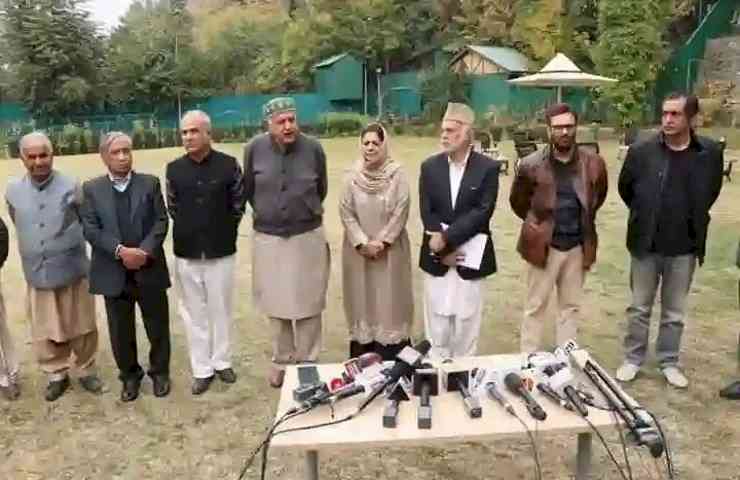Are Abdullahs and Muftis shedding crocodile tears as Jammu region gets set for stronger representation in proposed J&K Assembly?
Four particular Kashmir-based political parties, including the two widely perceived to be the friendlies of the ruling BJP at the Centre, with the support of the Communist Party of India (Marxist), have launched a concerted campaign to fail the Delimitation Commissions proposal of adding 6 seats to Jammu as compared to just 1 to Kashmir.

By Ahmed Ali Fayyaz
New Delhi, Jan 3: Four particular Kashmir-based political parties, including the two widely perceived to be the friendlies of the ruling BJP at the Centre, with the support of the Communist Party of India (Marxist), have launched a concerted campaign to fail the Delimitation Commissions proposal of adding 6 seats to Jammu as compared to just 1 to Kashmir.
On December 20, in its second meeting with the associate members - also attended by three National Conference (NC) Lok Sabha members who had boycotted the first meeting - the Delimitation Commission declared its proposal of adding one each seat to Kathua, Samba, Udhampur, Doda, Kishtwar and Rajouri districts in Jammu. As regards the valley, the Commission proposed to add one seat to only one district - Kupwara.
On the expected lines, all the parties with some footprint in Kashmir, with the understandable exception of the BJP, rejected the Commission's move on the ground that the proposed distribution would be grossly disproportionate to the population in the two provinces of the Union Territory.
The Commission headed by the retired Supreme Court of India judge, Ranjana Prakash Desai, has been constituted to add 7 seats to the Jammu & Kashmir Legislative Assembly as per the Jammu and Kashmir Reorganisation Act of 2019. After the erstwhile State lost its special status and Statehood in August 2019 and the Ladakh region was granted a separate UT, the J&K Legislative Assembly was reduced to a House of 83 seats - 46 in Kashmir and 37 in Jammu.
If the Commission goes ahead with its proposal, the Kashmir province would have 47 and Jammu 43 seats in the UT's first Legislative Assembly. Twenty-four seats will continue to remain notionally reserved for the Pakistan-occupied Kashmir. The elections would be conducted there as and when those territories would be administered by the Government of Jammu and Kashmir under the sovereignty of India.
The valley-based leadership is unanimously complaining that the gap of the seats between Kashmir and Jammu was being erased 'under a plan' so as to ensure that Jammu gets seats equal to Kashmir's despite a substantial difference between the populations of the two regions. The 'plan', according to the Kashmiri leaders, is to fulfil the BJP's agenda of installing a (Hindu) Chief Minister from Jammu. The NC and the Peoples Democratic Party (PDP) leaders have been invariably claiming that the BJP had floated two 'proxies' in Kashmir to realise its dream. Nonetheless, both the parties - Altaf Bukhari's Apni Party (AP) and Sajad Lone's Peoples Conference (PC) - have joined the chorus with Farooq Abdullah's NC and Mehbooba Mufti's PDP.
Both AP and PC, who are not part of Farooq-led Peoples Alliance for Gupkar Declaration (PAGD), have repeatedly denied being "BJP's 'B' team". The PC was the first to assail the Delimitation Commission proposal as "a brazen insult to the Kashmiris". Subsequently, the PAGD declared a programme of the 'silent and peaceful protest' against the Delimitation Commission proposal on 1 January 2022 which was foiled by the authorities.
According to the PAGD leaders' argument, the valley of Kashmir with a population of 68,88,475, as per Census-2011, should get 5 new seats and Jammu, with a population of 53,78,538 should get only 2. They argue that with the advantage of over 15 lakh souls, Kashmir (56.15%) should have a total of 51 seats and Jammu (43.85%) does not deserve more than 39 seats. Contrarily the Jammu mainstream has been claiming more seats on the basis of that province's area and hilly terrain.
The NC leaders, including the former Chief Minister Omar Abdullah, have pointed out that the maximum number of the Lok Sabha and Assembly seats was in the most populous State of the UP (population 19,98,12,341/area 2,40,928 sq. km), not in the largest area States like Rajasthan (population 6,85,48,437/area 3,42,239 sq. km), Madhya Pradesh (population 7,26,26,809/area 3,08,245 sq. km) and Maharashtra (population 11,23,74,333/area 3,07,713 sq. km). They also ask why Ladakh, with an area of 59,146 sq. km, had only 4 seats in the erstwhile J&K State in which Kashmir's and Jammu's total area was only 42,241 sq. km but it had 83 seats.
In other words, Jammu claims more seats on the basis of its area and Kashmir claims more for the size of its population.
For the population of 30 lakh people, 75 seats were created for Jammu and Kashmir's first universal suffrage in the State's Constituent Assembly in 1951 - one seat for 40,000 people. As per the size of the population, Kashmir got 45 seats, Jammu 28 and Ladakh 2. Thus Kashmir had 17 seats more than Jammu, even as Jammu's area was 26,293 sq. km and Kashmir's 15,948 sq. km.
The gap between Kashmir and Jammu was for the first time narrowed down from 17 to 13 in the State's first Assembly elections in 1957. Kashmir's seats were reduced from 45 to 43 and Jammu's increased from 28 to 30. Ladakh continued to have only 2 seats from 1951 to 1995.
Same apportionment - Kashmir 43, Jammu 30, Ladakh 02 - was observed in the Assembly elections of 1962. This was the time when Mufti Mohammad Sayeed returned as MLA, from Dachhnipora (today's Bijbehara). Congress party was the ultimate ruler from 1953 to 1975.
In 1967, when Mufti was elected as MLA from Bijbehara and inducted as Deputy Minister in G.M. Sadiq's Council of Ministers, the number of Kashmir seats was further reduced from 43 to 42 and Jammu's taken up to 31. Thus, the gap was reduced from 13 to 11. There was no change in the Assembly elections of 1972.
During the delimitation held in Emergency, the number of seats was left intact in Kashmir and Ladakh but one seat was added to Jammu. So, in the Assembly elections of 1977, 1983 and 1987, the number of seats was 42 in Kashmir and 32 in Jammu, bringing the gap down to 10.
In the delimitation held in another Congress regime at the Centre, the number of seats in J&K Assembly was increased from 76 (Kashmir 42, Jammu 32, Ladakh 02) to 87 (Kashmir 46, Jammu 37, Ladakh 04). With this alteration, the gap of the seats between Kashmir and Jammu was further reduced to 9. The Assembly elections of 1996, 2002, 2008 and 2014 were held as per the same apportionment.
Now that the current Delimitation Commission is seeking to further narrow down this gap from 9 to just 4 seats, the valley-based parties, who chose to remain mute spectators to all the changes from 1951 to 2019, have started peddling the victimhood and injustice narrative.
(The content is being carried under an arrangement with indianarrative.com)


 IANS
IANS 








